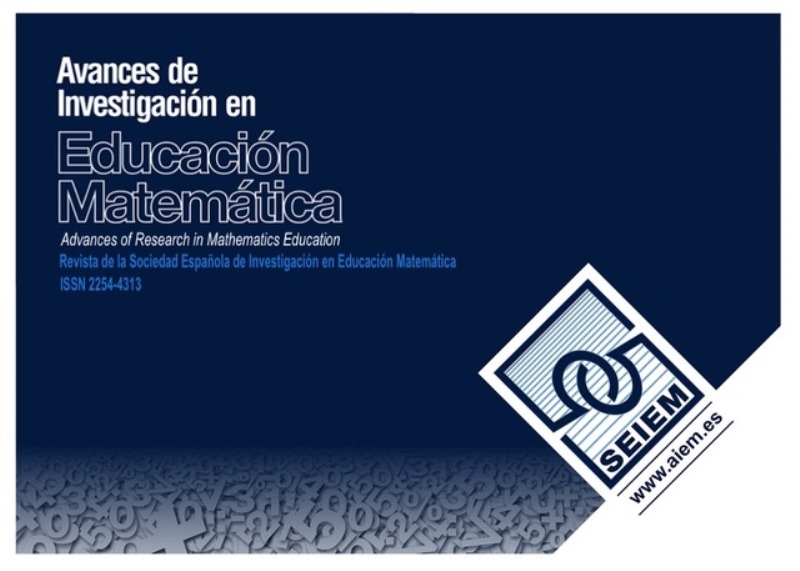Conexiones matemáticas en las estrategias de solución de problemas de álgebra de profesores de matemáticas de secundaria en formación
DOI:
https://doi.org/10.35763/aiem25.6354Palabras clave:
Álgebra, Conexiones matemáticas, Estrategias de solución, Futuros profesores de matemáticas de secundariaResumen
Este estudio investigó las conexiones matemáticas encontradas en las soluciones proporcionadas por 22 futuros profesores de matemáticas de secundaria a un conjunto de problemas de álgebra. El interés y la investigación sobre las conexiones matemáticas han ganado importancia en la última década. Se utiliza la Teoría Extendida de las Conexiones Matemáticas o ETMC para explorar los tipos de conexiones que este marco captura y no captura en las soluciones de los futuros profesores. El ETMC reveló cuatro tipos de conexiones matemáticas en cuatro problemas: “representaciones diferentes”, “procedimiento”, “parte-todo” y “significado”. Los otros tipos de conexiones definidas en ETMC, como “reversibilidad” o “característica”, no se encontraron en nuestros datos, quizás debido a los problemas específicos que se utilizaron. Algunas conexiones matemáticas no se pusieron de manifiesto al examinar las soluciones a través de ETMC (“significado”, “implicación o si/entonces” y modelado), mostrando áreas en las que ETMC podría tener una capacidad limitada para ayudar a los investigadores a identificar conexiones matemáticas en diferentes contextos.
Descargas
Citas
Australian Curriculum, Assessment and Reporting Authority (2022). The Australian Curriculum: Mathematics. Author.
Businskas, A.M. (2008). Conversations about connections: How secondary mathematics teachers conceptualize and contend with mathematical connections [Unpublished doctoral dissertation]. Simon Fraser University, Canada.
Common Core State Standards Initiative (2022). Standards for Mathematical Practice. Author.
Department for Education (2021). National curriculum in England: Mathematics programmes of study. Gov. UK.
Dogan, H., Shear, E., Contreras, A.F.G., & Hoffman, L. (2022). Linear independence from a perspective of connections. International Journal of Mathematical Education in Science and Technology, 53(1), 190-205. https://doi.org/10.1080/0020739X.2021.1961031
Dolores-Flores, C., Rivera-López, M.I., & García-García, J. (2019). Exploring mathematical connections of pre-university students through tasks involving rates of change. International Journal of Mathematical Education in Science and Technology, 50(3), 369-389. https://doi.org/10.1080/0020739X.2018.1507050
Eli, J.A., Mohr-Schroeder, M.J., & Lee, C.W. (2011). Exploring mathematical connections of prospective middle-grades teachers through card-sorting tasks. Mathematics Education Research Journal, 23, 297-319. https://doi.org/10.1007/s13394-011-0017-0
García-García, J., & Dolores-Flores, C. (2018). Intra-mathematical connections made by high school students in performing Calculus tasks. International Journal of Mathematical Education in Science and Technology, 49(2), 227-252. https://doi.org/10.1080/0020739X.2017.1355994
García-García, J., & Dolores-Flores, C. (2021). Exploring pre-university students’ mathematical connections when solving Calculus application problems. International Journal of Mathematical Education in Science and Technology, 52(6), 912-936. https://doi.org/10.1080/0020739X.2020.1729429
Hatisaru, V. (2022). Investigating secondary mathematics teachers’ analogies to function. International Journal of Mathematical Education in Science and Technology. https://doi.org/10.1080/0020739X.2022.2032440
Hatisaru, V. (2023). Mathematical connections established in the teaching of functions. Teaching Mathematics and its Applications: An International Journal of the IMA, 42(3), 207-227. https://doi.org/10.1093/teamat/hrac013
Ito-Hino, K. (1995). Students’ reasoning and mathematical connections in the Japanese classroom. In P. House, & A.F. Coxford (Eds.), Connecting mathematics across the curriculum (pp. 233-245). NCTM.
Kieran, C. (1992). The learning and teaching of school algebra. In D. A. Grouws (Ed.), Handbook of research on mathematics teaching and learning (pp. 390-419). Macmillan Publishing.
Musser, G.L., Burger, F.W., & Peterson, B.E. (2008). Mathematics for elementary teachers: A contemporary approach. Wiley.
Mhlolo, M.K. (2013 ). Mathematical connections of a higher cognitive level: A tool we may use to identify these in practice. African Journal of Research in Mathematics, Science and Technology Education, 16(2), 176-191. https://doi.org/10.1080/10288457.2012.10740738
Rodríguez-Nieto, C.A., Cervantes-Barraza, J.A., & Font, V.F. (2023). Exploring mathematical connections in the context of proof and mathematical argumentation: A new proposal of networking of theories. Eurasia Journal of Mathematics, Science and Technology Education, 19(5), em2264. https://doi.org/10.29333/ejmste/13157
Rodríguez-Nieto, C.A., Font, V.F., Borji, V., & Rodríguez-Vásquez, F.M. (2022) Mathematical connections from a networking of theories between extended theory of mathematical connections and onto-semiotic approach. International Journal of Mathematical Education in Science and Technology, 53(9), 2364-2390. https://doi.org/10.1080/0020739X.2021.1875071
Rodríguez-Nieto, C.A., Rodríguez-Vásquez, F.M., & Font, V.F. (2022). A new view about connections: the mathematical connections established by a teacher when teaching the derivative. International Journal of Mathematical Education in Science and Technology, 53(6), 1231-1256. https://doi.org/10.1080/0020739X.2020.1799254
Stacey, K., & MacGregor, M. (1999). Learning the algebraic method of solving problems. Journal of Mathematical Behavior, 18(2), 149-167. https://doi.org/10.1016/S0732-3123(99)00026-7
Stillman, G. (1998). The emperor’s new clothes? Teaching and assessment of mathematical applications at the senior level. In P. Galbraith, W. Blum, G. Booker, & D. Huntley (Eds.), Mathematical modelling: Teaching and assessment in a technology-rich world (pp. 243-253). Horwood.
Tripathi, N.P. (2008). Developing mathematical understanding through multiple representations. Mathematics Teaching in the Middle School, 13(8), 438-445. https://doi.org/10.5951/MTMS.13.8.0438
Descargas
Publicado
Cómo citar
Número
Sección
Licencia
Derechos de autor 2024 Vesife Hatisaru, Kaye Stacey, Jon Star

Esta obra está bajo una licencia internacional Creative Commons Atribución 4.0.
Los trabajos se publican bajo una licencia de Creative Commons: Reconocimiento 4.0 España a partir del número 21 (2022).
Los autores que publican en esta revista están de acuerdo con los siguientes términos:
- Los autores conservan los derechos de autor y el reconocimiento de la autoría.
- Los textos publicados en esta revista están sujetos –si no se indica lo contrario– a una licencia de Reconocimiento 4.0 Internacional de Creative Commons. Puede copiarlos, distribuirlos, comunicarlos públicamente, hacer obras derivadas y usos comerciales siempre que reconozca los créditos de las obras (autoría, nombre de la revista, institución editora) de la manera especificada por los autores o por la revista. La licencia completa se puede consultar en http://creativecommons.org/licenses/by/4.0.
- Los autores pueden establecer por separado acuerdos adicionales para la distribución no exclusiva de la versión de la obra publicada en la revista (por ejemplo, situarlo en un repositorio institucional o publicarlo en un libro), con un reconocimiento de su publicación inicial en esta revista.
- Se permite y se anima a los autores a difundir sus trabajos electrónicamente (por ejemplo, en repositorios institucionales o en su propio sitio web) antes y durante el proceso de envío, ya que puede dar lugar a intercambios productivos, así como a una citación más temprana y mayor de los trabajos publicados (Véase The Effect of Open Access) (en inglés).









